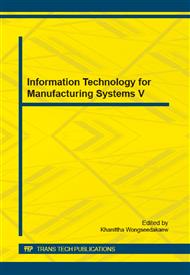[1]
Zhao Shida, et al. Development of emergency shelters query software based on Android [J]. Application of Electronic Technique, 2014, 40(3): 133-136.
Google Scholar
[2]
Zhu Gang, Ma Liang. Location model of logistics system [J]. Journal of University of Shanghai for Science and Technology, 2006 (1): 19-22.
Google Scholar
[3]
Yang Zhaosheng, Gao Xueying, Sun Di. Cellular automata model of city traffic emergency evacuation and rescue [J]. Journal of traffic and Transportation Engineering, 2011, 2(4): 114-120.
Google Scholar
[4]
Yue Hao. Study on the simulation model of pedestrian flow based on Cellular Automata [D]. Beijing, Beijing Jiaotong University. 2008 : 14-25.
Google Scholar
[5]
Heather Betel, Paola Flocchini. On the asymptoti behavior of fuzzy cellular Automata[J]. Electronic Notes in Theoretical Computer Science, 2009, 252: 23-40.
DOI: 10.1016/j.entcs.2009.09.012
Google Scholar
[6]
Gong Q L, MENDEL J M. Interval type-2 fuzzy logic systems: theory and design[J]. IEEE Transactions on Fuzzy Systems, 2000, 8(5): 535-550.
DOI: 10.1109/91.873577
Google Scholar
[7]
Zhu Yi, Yang Lizhong, Li Jian. Cellular Automata simulation of occupant evacuation in different rooms [J]. Fire Safety Science, 2007, 16(3): 175-179.
Google Scholar
[8]
ZHANG Junna, FAN Haiju. Crowd evacuation system simulation based on artificial potential field and Agent[J]. Journal of Computer Applications, 2012, 32(6): 1753-1756.
DOI: 10.3724/sp.j.1087.2012.01753
Google Scholar
[9]
B. Steffen, A. Seyfried Methods for measuring pedestrian density, flow, speed and direction with minimal scatter[J]. Physica A: Statistical Mechanics and its Applications, 2009, 12: 015.
DOI: 10.1016/j.physa.2009.12.015
Google Scholar
[10]
Daichi Yanagisawa, et al. Mean-field theory for pedestrian outflow through an exit[J]. Physical Review E - PHYS REV E , vol. 76, no. 6, (2007).
DOI: 10.1103/physreve.76.061117
Google Scholar
[11]
Ansgar Kirchner, et al. Friction effects and clogging in a cellular automaton model for pedestrian dynamics[J]. Physical Review E - PHYS REV E , Vol. 67, p.056122, (2003).
DOI: 10.1103/physreve.67.056122
Google Scholar
[12]
Daichi Yanagisawa, et al. Analysis on Pedestrian Outflow through an Exit with an Obstacle[C]. ICROS-SICE International Joint Conference 2009, 8: 5040-5045.
Google Scholar
[13]
Yushi Suma, et al. Anticipation effect in pedestrian dynamics: Modeling and experiments[J]. Physica A: Statistical Mechanics and its Applications 2012, 391(1): 248-263.
DOI: 10.1016/j.physa.2011.07.022
Google Scholar


